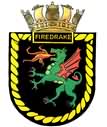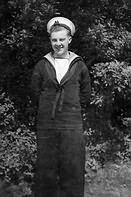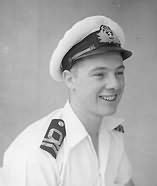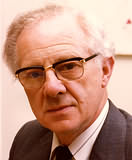 |
|
My short time with
the Firedrake
by Ken Neale OBE, FSA. |
 |
For
me the war was the London blitz, a brief spell in the Essex Home
Guard, but mainly the Royal Navy and my marriage to Dorothy in 1943.
I had been brought up in the south of England, far from the haunts
of my Scottish ancestors whose working lives had been passed on
our fishing trawlers working out of Aberdeen. It never seemed remotely
possible that I would go to sea. However in 1939, the war clouds gathered over Europe and burst across Poland. I was to serve in the North Atlantic, the Mediterranean and the Pacific in destroyers, a battleship and an aircraft carrier. So on 7th October 1941 my father went with me to Kings Cross station where I caught the train to Skegness (HMS Arthur) a wartime training establishment. Photo left: Ken as a ordinary seaman just about to join the Firedrake. |
| Once
there it was discovered that could read and so I was, to my surprise,
enlisted as an Ordinary Telegraphist rather than as I had expected
an Ordinary Seaman. However, such are the ways of authority, shortly
afterwards I was told I was selected to be trained for a commission
and that required a period of experience at sea as a seaman. So my career as a ‘Sparks’, as a Telegraphist were known only in reference, my training in Morse code signaling, was extremely brief. I was rapidly re-rated and dispatched from Skegness to Shotley (HMS Ganges) in Suffolk to be trained in seamanship. This little story, however begins on the Clyde in Scotland. It was necessary to serve time as a seaman for a period before one could enjoy the privileges of the Royal Navy College at Greenwich. Thus, as an aspiring young sailor I was drafted from the historical naval base at Chatham to join HMS Firedrake (the fire dragon) at Greenock. That was just what I had hoped for when I volunteered for the Royal Navy; a fleet destroyer, one of the fighting ‘Fs’ (Fame, Fury, Fortune, Foxhound, Foresight, Fearless, Forester, Faulknor and the Firedrake), which already had a claim to fame. To my disappointment she had just sailed on convoy escort duty in the Atlantic leading her flotilla of flower class corvettes which bore delightful names, which we cherished, like Dianthus, Marigold and Loosestrife. So I had to wait several weeks before she returned so I could report on board, as it happened, in Londonderry. Thus I found myself at the harbour in Greenock and, as an interim experience I found myself waiting and working , on a Scottish fishing trawler the Shepherd Lad. It was a sturdy, workaday, coal-burning with salt-caked smoke stack, and crewed by a few splendid Scottish seamen, then more concerned with mines rather than fish. ‘Touch Cauld Iron’ for luck was the slogan of these superstitious and stalwart British seafarers. I felt quite at home and comfortable with recollections of my family background. It seemed inevitable after all. War, as I have remarked changed peoples lives. I joined the Firedrake in February 1942 for my six months sea training. HMS Firedrake, with an already distinguished war record, was the leader of the 7th Londonderry Escort Force on the North Atlantic convoy duties. When reached her mooring alongside Lough Foyle she looked grey, ship-shape and purposeful with the extra armament and crew that war time roles required. There were more antiaircraft guns, depth charges and technical equipment all of which had to be manned. One consequence was that there were insufficient space and hooks on which to ‘sling’ hammocks below deck where the seaman lived and slept. So I with others had to roll out our hammocks on the deck against the bulkhead. As the crew came off watch during the night, with the ship rolling, they could not avoid walking on us and the water dripped off their oilskins. So we were wet, tired and not sorry to get up and go on watch ourselves. My watch duty was on the bridge with the Captain or officer of the watch and serve as his runner, at action stations my post was the A.A. gun on the starboard platform. It was very rewarding to serve under a Captain (Commander Banks) who set such a magnificent example of professional seamanship and was ice-cool in every situation. Even when ordering depth charges to be fired at marauding U-boats which had attacked the convoy he would chat quietly away keeping everyone calm and focused on their job. |
| He
would also communicate with assurance and an obviously caring but
convincing authority with the Flower class corvettes that were shepherding
the slow merchant ships across the Atlantic. The crew knew their
drills and greatly admired the Captain and had an obvious pride
in the ship. Life on board the Firedrake was testing but a marvellous experience, thrilling and fulfilling in many ways. She was a small ship with great responsibilities, in a vast and angry ocean in which, deep-down lurked a formidable enemy. She lies now at the bottom of the Atlantic; most of her crew perished in the torpedo attack on the night of 16/17 December 1942. I had left her in August for HMS King Alfred at Hove and the Royal Naval College at Greenwich to be trained and commissioned as an R.N.V.R. Officer. The Firedrake and her crew especially two or three of my closest companions meant a lot to me and their loss was a poignant and personal event. A ship’s crew, when it is in top form, is a wonderful team to belong to. In the north Atlantic these men showed their metal and many excelled themselves. The seaman I served with on this ship naturally had a slightly ambivalent attitude to me as it was known that I might shortly be their superior officer in another role. But we got along and I had to perform well not only to satisfy Commander Banks, on whom my future in the Navy depended, but also to demonstrate to the crew that I could do what they did. It was all very worth while. In retrospect I have even forgiven them the mess-deck music(?) which consisted of about three or four recorded pieces ‘Deep in the heart of Texas’ and ‘Amapola’ for example - played hour upon hour; it was dreadful and the raucous ‘action stations’ hooters which brought all that to an abrupt halt were almost a relief! |
| After
delivering the merchant ships into safe waters off the coast of
North America we would go to Argentia and Placentia Bay in Newfoundland,
where Winston Churchill and President Roosevelt agreed the Atlantic
Charter in 1941. After refueling the orders were to proceed to Boston
in New England for necessary repairs, and then to a rendezvous with
an eastbound convoy along with our ‘bunch of flowers’ the plucky
corvettes. Back in Londonderry we might get a little leave and take
home the ‘goodies’ we had bought in America for our rationed families.
The Irish from Donegal, who were neutral, rowed out to the ships
to sell us fresh butter another popular commodities for our families
in the island fortress that Britain became. The time came fortunately for me, when I was recalled ashore for training for a commission. I said good-bye to the Captain who gave me his best wishes and much encouragement; and more informally, to my splendid shipmates. Shortly afterwards the Captain would have moved on to another ship, and most of the crew would be lost. After passing out fourth in my class at Greenwich I was drafted to ‘Glendower’, Pwhilli in north Wales to train recruits. I wanted to get back to sea so applied and obtained a course at HMS Heron to learn the deployment and operational use of aircraft (Fleet Air Arm) once qualified I was appointed to HMS Anson the flag ship of the 1st Battle Squadron in the British Pacific Fleet. I joined her at Plymouth while she was being refitted so Dorothy my wife was able to spend a short time there with me. |
| Picking
my way over the dockyard servicing cables and other paraphernalia
I reported on board and was allocated my cabin and steward before
being introduced to the Captain, Alexander Madden and the Fighter
Direction team. Sailors, specialists and dockyard staff were mingled all over the great ship preparing it for a long voyage following some sea trials and working up the gun crews with live firing practice which we carried out in the Atlantic and at Scapa Flow in the Orkney Islands. Then it was back into the Atlantic which had been our battleground in the Firedrake, now sadly broken and on the ocean floor. This time, however, our track took us not to the west, but round the beautiful Scottish islands and south to Biscay and Gibraltar. Then to Malta where with searchlights flooding the sky as we celebrated VE day, and then to port Said. |
 Ken as an Officer on HMS Anson |
| The Suez canal rarely saw ships as large and powerful as Anson, which seemed strangely Leviathan alongside the Arab dhows and camel trains. The sailors had a break ashore at Ismailia, the first time since Malta, before we steamed on to Socotra, Colombo and Trincomalee in Ceylon (Sri Lanka). Colombo had a handsome colonial image but the crew were more concerned in enjoy themselves, than with distinguished architecture. However, there was no serious discipline problems although the antics of some of the midshipmen were immature and eccentric. |
| The
long days at sea were occupied with shipboard routines and the working
up of the action drills and gun teams. During the voyage to Fremantle,
Perth and Western Australia there was the crossing of the line (Equator)
which was celebrated with traditional ceremony in fine style. My team was more concerned with calibrating the radar, and liaison with the aircrews on the accompanying aircraft carriers, than with Father Neptune, but no one was excused and the first timers duly received the traditional certificate. |
| After
Sydney there were major developments - the ship was rapidly refitted
and provisioned for the Pacific - the atomic bombs were dropped
on Hiroshima and Nagasaki the Japanese had capitulated so we steamed
as fast as we could to take the surrender of Hong Kong and try to
restore the Colony to British control. After years of neglect during
the Japanese occupation, Hong Kong was in a dreadful state. Most
distressing was the state of the prisoners of war, men and women,
civilians, troops and nurses, we released. The Japanese were rounded up and the formal surrender took place with due ceremony, then followed the victory parades and marches. As there was no civil administration or military personnel we put sailors and marines ashore to corral the Japanese troops, subdue the reckless Chinese pirates and looters and try, as far as possible, to restore the Colony to some semblance of order and normality. While I was in Hong Kong I received a signal from my wife Dorothy via Admiralty wireless links telling me of Peters birth on the 27th August 1945 and this was celebrated in the wardroom. But the mission continued, our next task was to take senior Japanese officers to Tokyo for trial and in some cases execution for war crimes. |
| We
sailed into Sagami Bay under the looming presence of the great lantern
in the sky that was Fujiyama and went ashore then taking a train
through the ruins of Yokohama and up to the devastated capital.
Some of us later went to see the awful destruction caused by the
nuclear explosions. Our sailors hardly knew what to make of it all,
but were kept busy as there were tasks that needed to be done. After our purposes in Japan were satisfied we returned briefly to Hong Kong and thence back, via the Philippines, Celebes and south Australia. As the flagship it fell to HMS Anson to carry the Duke and Duchess of Gloucester the (Governor General) on a ‘Victory’ tour of the continent which the sailors, although by now impatient to get home to Britain after many years of war service, enjoyed. For Alexander Madden this was his last voyage as a Captain, for his promotion to Rear Admiral was announced to the delight of all who admired him. He was a fine man, erudite, inspiring and endowed with the highest attributes of a seasoned naval commander. When I congratulated him on his elevation to flag rank he replied, with a tinge of sincere regret, that it meat that he would never again be at sea in command of his own ship. He would always fly his flag in another captain’s ship. He did in fact in HMS London during the Yiangtse incident in 1949. His promotion was but another step to higher status in the Royal Navy: he eventually became Second Sea Lord. I was transferred to an aircraft carrier, HMS Patroller, a converted American merchant ship and eventually returned home on board that ship. We arrived in Plymouth for a short leave prior to demobilisation - took a train to Waterloo station in London where my father awaited me with transport for my kit. Then it was home to Dorothy and Peter who I had not then seen. There is much more that could be written of what was a definitive experience of service with the Royal Navy in some of its finest ships and with its splendid sailors, but this must suffice for the present. |
 |
|
Ken
Neale OBE, FSA.
Today |
| Many years later Dorothy and I, in the pursuit of family background and fishing history, used to visit the fine Scottish Fisheries Museum at the harbour head in Anstruther, Fife. By the door in the courtyard was a life-belt displayed there as a maritime symbol of the traditional trawler fleet - it carried the name Shepherd Lad. |
|
Other
Pages Below
|